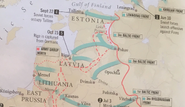The Baltic Offensive (14 September-24 November 1944) was a strategic offensive executed by the Red Army's northern fronts against the German Army Group North in the Baltic states during the autumn of 1944. The result of the series of battles was the isolation and encirclement of Army Group North in the Courland Pocket and the Soviet re-occupation of the Baltics.
Campaign[]
Following the advance to Warsaw, the Stavka's operational focus now shifted north to the Baltics. The German Army Group North faced four Red Army fronts whose goal was to liberate Estonia, Latvia, and Lithuania. By the end of July the Leningrad Front had captured Narva on the Baltic coast, the 3rd Baltic Front had driven deep into Latvia and Estonia, and the 2nd and 1st Baltic Fronts had thrust toward Riga and Memel, so severing land communications between Army Groups North and Center. On 16 August, the Germans launched a counterattack which briefly reestablished a land link between the two army groups and offered Army Group North an opportunity to pull out of the Baltic states with all its heavy equipment. Hitler, however, spurned the opportunity. The Red Army went on the offensive again in mid-September. Tallinn, the Estonian capital, was taken on 22 September, and Riga fell on 15 October. By mid-October the coast around Memel had been secured, but the city itself was to hold out until January 1945. 26 divisions of Army Group North withdrew to the Courland peninsula, where they remained until the end of the war in order to provide the Kriegsmarine with continuing access to Baltic waters for the training of U-boat crews.

